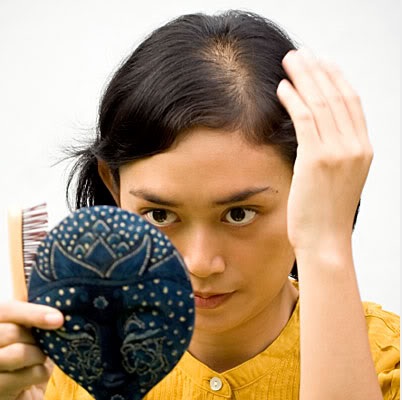
Hair Loss Information For Women : Start By Understanding the General Causes of Hair Loss
When noticeable amounts of shedding occur, many people panic and immediately look for products to buy. However, treatment and prevention should start by understanding the different causes that may be at work in women.
Differences in Hair Loss Between Men and Women
Like men, women can also inherit a genetic predisposition to pattern baldness. This means that the DNA will carry instructions for creating weaker protein receptors on the hair follicles which are more sensitive to the effects of DHT (dehydrotestosterone). DHT is a testosterone breakdown product that we all have. When it binds to the sensitive receptors, it will prevent the normal uptake of nutrients, causing the hair follicle to starve and miniaturize.
In an interview with American Health Journal on baldness, hair transplant expert, Dr. Sanusi Umar explained that in women, the effect of DHT is often compounded with hormonal dynamics. This can include general fluctuations in hormonal levels or changes related to menopause or pregnancy. The multiple factors which can contribute to female hair loss therefore make drug treatments more challenging.
While genetic predispositions cannot be changed, the rate of hair loss can be influenced by environmental factors such as:
(1) sun exposure
(2) pollutants
(3) smoking and heavy alcohol consumption
(4) dietary deficiencies
Thyroid Imbalances
Thyroid disorders are among the most common causes of hair loss besides genetics. This includes:
(1) hypothyroidism
(2) hyperthyroidism
Drug treatment is often very effective in restoring balance to the thyroid gland. And in most cases, hair regrowth is quite feasible within a year.
Drug Side Effects
Loss of hair is a side effect associated with many drugs. In particular, oral contraceptives is an exceedingly common cause of hair thinning and shedding in females. After all, millions of birth control prescriptions are written each year.
These drugs work to suppress ovulation by targeting estrogen and progestin. The full list of side effects is not always discussed between patient and doctor. And this is probably why most women are not aware that birth control pills can cause them to lose hair.
Tight Hair Styling Practices
The look of full, lustrous hair is highly coveted by many women. And the use of extensions by celebrities has popularized this beauty practice. However, these hair pieces add weight and tension to the roots of hair follicles. This increases their likelihood of tearing and become infected or inflamed. These chronic pulling forces on the hair root eventually results in a hair loss condition called traction alopecia which affects individuals of any race.
Treating Female Hair Loss
As a leading hair restoration specialist, Dr. Umar helps both men and women overcome hair loss challenges. He recommends that treatment for female hair loss should start as soon as the individual notices that their hair is shedding or thinning more than usual. Waiting or hoping that the condition will go away can cause more serious issues that are harder to correct.
Seeing a doctor should be considered as the first step. According to Dr. Umar, a physician can perform blood tests and issue a formal diagnosis. Based on this information, it is possible to address the causes of hair loss and choose the most appropriate treatment. Options for women may include:
(1) Use of Rogaine 2%. The 5% concentration may be used under a doctor’s guidance
(2) Off label usage of prescriptions such as Spironolactone or Cimetidine if the condition is primarily attributed to DHT.
(3) Thyroid medications (if this is relevant)
(4) Dietary supplementation (e.g. iron) which should be directed by a doctor
(3) Hair transplantation, if the patient has enough donor hair (non thinning) on their scalp.
Understanding causes will help women suffering from hair loss to avoid the mistake of impulsively purchasing products that may not be relevant to their particular condition.
All information contained within this site is for reference purposes only. You must consult and follow the directions of your physician and licensed health care professionals.

